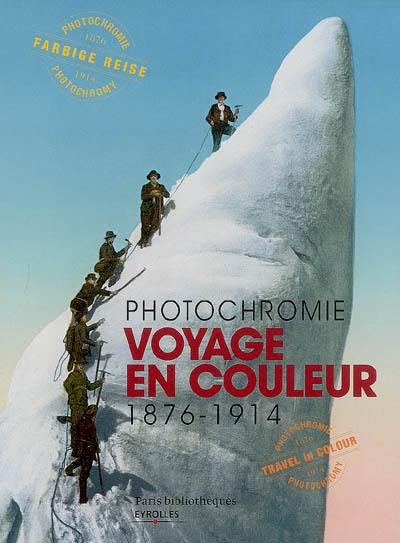
Fiche technique
Format : Broché
Nb de pages : 191 pages
Poids : 1095 g
Dimensions : 22cm X 28cm
ISBN : 978-2-212-54270-7
EAN : 9782212542707
Quatrième de couverture
Entre photographie et lithographie, le procédé Photochrom permet d'obtenir une image en couleur à partir d'un négatif noir et blanc. Inventé conjointement par le Français Léon Vidal et le Suisse Hans Jakob Schmid, le procédé breveté en 1888 par la société zurichoise Orell Füssil, remporta un premier prix à l'Exposition universelle de 1889.
Premières images en couleur d'un monde en pleine évolution, les photochromes sont diffusés sur les principaux sites de villégiature d'Europe, puis des États-Unis. Les touristes adorent ces vues tellement plus vraies que les photographies en sépia ou colorisées : paysages d'Égypte et de Palestine, souvenirs de Venise, des Alpes ou de la Riviera, vues des fjords norvégiens, du Rhin, de la Volga, de la Tamise, du Gange à Bénarès...
Au tournant du XXe siècle, ce sont les chutes du Niagara, le Grand Canyon, les steamers du Mississippi, les gratte ciel de New York
L'usage particulier de la couleur rend aujourd'hui ces images bizarrement fascinantes, en nous faisant sentir l'incroyable décalage du temps. Le dépaysement est encore plus fort dans les vues « exotiques » (Afrique du Nord, Moyen-Orient, Inde, Chine, Cuba...), qui survivent dans notre inconscient comme une sorte d'ailleurs idéal.
Halfway between photography and lithography, the Photochrom process made it possible to obtain colour images from black and white negatives. It was co-invented by Frenchman Léon Vidal and Swiss lithographer Hans Jakob Schmid.
Parented in 1888 by the Zurich firm Orell Füssli, the process was awarded a first prize at the World Fair of 1889.
Photochroms - the first colour images of a fast-changing world - were circulated to the main holiday resorts in Europe, then in the United States, and were extremety popular with tourists who found them far more realistic than tinted or sepia photographs. They included landscapes of Egypt and Palestine, souvenirs of Venice, the Alps and the Riviera, views of the Norwegian fjords, the Rhine, the Volga, the Thames, the Ganges at Benares... followed by Niagara Falls, the Grand Canyon, steamers on the Mississippi and New York skyscrapers at the turn of the 20th century.
The special colouring technique used for these images gives them a strange fascination, conveying a sense of history and otherness. This impression is all the stronger in the « exotic » views of North Africa, the Middle East, India, China, or Cuba, which are stored in our unconscious as images of an ideal « elsewhere ».
Auf halbem Weg zwischen Fotografie und Lithografie ermöglicht es das Photochrom - Prozess, ein Farbbild aus einem.
Schwarzwei(...)negativ zu gewinnen. Das verfahren, das von dem Franzosen Léon Vidal und dem Schweizer Hans Jakob Schmio gemeinsam erfunden und 1888 vom Artistischen Institut Orell Füssli in Zürich zum Patent angemeldet wurde, erhielt bei der Weltaussteflung von 1889 einen ersten Preis. Als erste Farbbilder einer Welt in vollem. Umbruch werden die Photochroms an den wichtigsten Urlaubsorten Europas und später auch der USA verbreitet. Die Touristen lieben diese Bilder, die so viel wirkilchkeitsgetreuer sind als mit Sepia getönte oder kolonerte Fotografien : tandschaften aus Agypten und Palastina, Souvenirfotos von Vénedig, den Alpen oder der Riviera, Ansichten der norwegischen Fjorde, des Rheins, der Wolga, der Themse, des Ganges in Benares... An der Wende zum 20 Jahrhundert sind es dann die Niagarafälle, der Grand Canyon, die Dampter auf dem Mississippi, die Wolkenkratzer von New York.
Die besondere Verwendung der Farbe macht diese Bilder heurte auf seltsame Weise taszinierend, da sie uns den unfasslichen Zeitabstand spüren lässt. Die Verfremdung ist noch stärker bei den « exotischen » Ansichten (Nordafrika, Mittlerer Osten, Indien, China, Kuba...), die in unserem Unbewussten ais eme Art ideales Anderswo überdauern.






